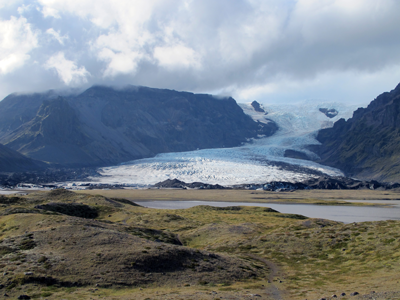Polar ice caps, atmosphere, and climate on Mars are best interpreted as an ensemble.
Mars’s polar regions are of special interest to both atmospheric scientists and geologists. The poles exhibit unique atmospheric processes that periodically spill over into the lower latitudes in the form of storms. The polar ice caps (and their extensions in the form of lower-latitude ground ice deposits) are geological deposits intimately connected to the atmosphere. They are also known records of climate variations. Thus, the polar ice caps, atmosphere, and climate are best interpreted as an ensemble.
In this sense, Mars polar science is uniquely multidisciplinary. For the last 2 decades, the research community has benefited from periodic International Conferences on Mars Polar Science and Exploration, the most recent of which was in 2011.
To discuss recent observations and interpretations since the fifth conference in 2011, more than 100 attendees from 11 countries attended the Sixth International Conference on Mars Polar Science and Exploration. Young scientists comprise nearly a quarter of the Mars polar community—22 of the attendees were student participants—which suggests that recent exciting discoveries are attracting new researchers.
Presentations showed evidence of active atmospheric and surface processes that shape the polar layered deposits (PLDs) and nearby landforms. Additionally, the north and south PLDs contain many layers of water ice and dust (southern PLDs also have layers of carbon dioxide) that have been used to constrain the history of accumulation at the poles and extract records of climate.

Finally, ongoing geomorphic activity points to widespread volatile transport between the poles and midlatitudes. These volatiles, especially carbon dioxide frost, modify the surface of dunes, gullies, and landforms. Presenters noted that some features on Mars have no terrestrial analogues because they are modified by carbon dioxide ice, which does not form on Earth.
In addition to the oral and poster technical sessions, the conference offered seven field trip options to participants and guests. Visits to Iceland’s dramatic Mars glacial and volcanic analogue sites attracted widespread participation.
The conference was organized with the goals of demonstrating what the community has learned in the last 5 years and agreeing on the most important unresolved scientific questions for Mars polar science.
A team of synthesizers collected points of interest from the discussions. The team defined five major categories of questions:
- Polar atmosphere: What are the dynamical and physical atmospheric processes at various spatial and temporal scales in the polar regions, and how do they contribute to the global cycle of volatiles and dust?
- Perennial polar ices: What do the characteristics of the polar ice deposits reveal about their formation and evolution?
- Past climate polar record: How has Mars’s climate evolved through geologic history, what are the absolute ages of the observable climate records, and how should we interpret the records of past states?
- Nonpolar ice: What is the history and present state of the middle- and low-latitude volatile reservoirs?
- Present-day surface activity: What are the roles of volatiles and dust in surface processes actively shaping the present polar regions of Mars?
Institutional support for the conference was provided by the NASA Mars Program Office, the European Geosciences Union, and the International Association of Cryospheric Sciences. Additional support came from the Icelandic Meteorological Office, the Planetary Science Institute, and the University of Iceland.
The full conference program and abstracts can be found on the conference’s website.
—Isaac Smith (email: [email protected]), Planetary Science Institute, Lakewood, Colo.; David Beaty, Jet Propulsion Laboratory, California Institute of Technology, Pasadena; and Thorsteinn Thorsteinsson, Icelandic Meteorological Office, Reykjavík, Iceland
Citation:
Smith, I., D. Beaty, and T. Thorsteinsson (2017), Mars polar intrigue spurs multidisciplinary collaboration, Eos, 98, https://doi.org/10.1029/2017EO069599. Published on 20 March 2017.
Text © 2017. The authors. CC BY-NC-ND 3.0
Except where otherwise noted, images are subject to copyright. Any reuse without express permission from the copyright owner is prohibited.

